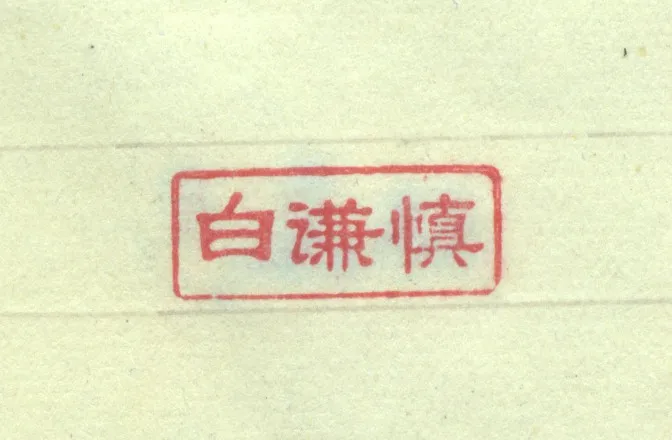
Zhang Naiqi (1897-1977), a modern Chinese political activist, economist, financier and collector of cultural relics. Zhang Naiqi once donated a large number of important cultural relics in his collection to the Palace Museum and the National Museum of China. In 2017, the National Museum of China held the "Patriotic Feelings-Zhang Naiqi Donated Cultural Relics Exhibition", and selected the Neolithic jade and Ming and Qing porcelains he donated. More than 130 precious cultural relics are exhibited, from which we can fully feel the patriotic feelings of Mr. Zhang Naiqi.
The Paper has learned that the chronological work "Zhang Naiqi Chronicle Long Edition", which describes Zhang Naiqi's life from birth to death for 81 years, was recently published for the first time by Shanghai Jiao Tong University Press. This monograph is edited by Pan Daming as the chief editor and main author, and edited by Qingtian Zhang Naiqi Research Association. The book comprehensively records Zhang Naiqi's life and various activities in which he participated, especially his role in some major historical events. The Paper's special selection issue "Chronology of Zhang Naiqi Long Edition" and the introduction and entry of Zhang Naiqi's cultural relics donation.
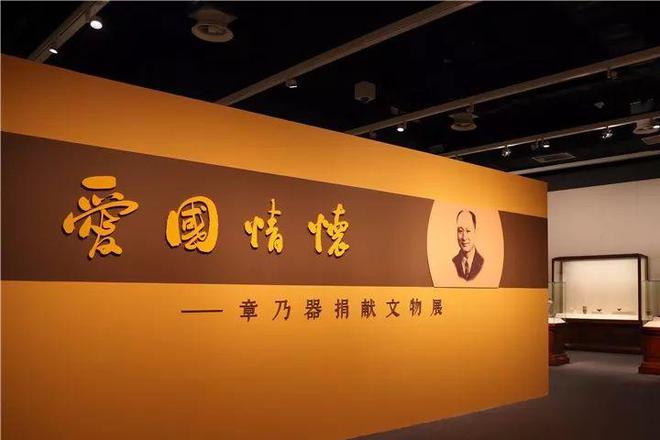
In 2017, "Patriotic Feelings - Exhibition of Cultural Relics Donated by Zhang Naiqi" was held in the National Museum of China
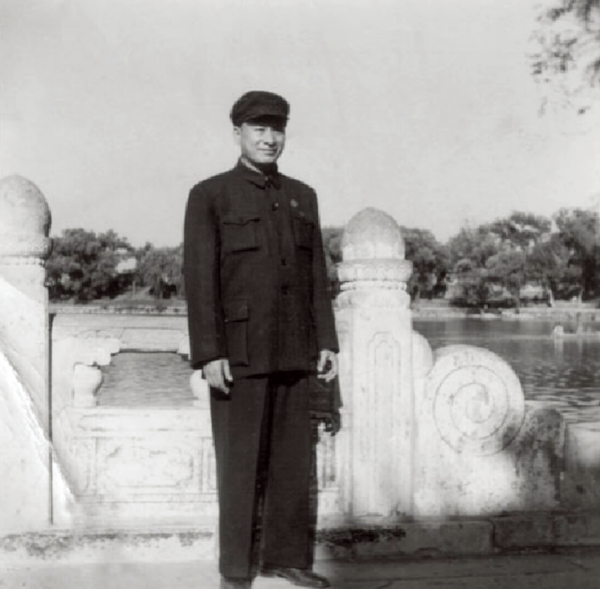
Zhang Naiqi's Old Shadow

"Chronology of Zhang Naiqi Long Compilation" book shadow
one
Around the late 1980s, I voluntarily requested to be transferred from the post of secretary in a government agency to work in a cultural institution, in order to get close to my favorite history and culture. Since then, he came into contact with the "Seven Gentlemen" incident and the parties involved in the incident, and became very interested in Zhang Naiqi. He played an important role in the founding period of the National Salvation Association and the "Seven Gentlemen" incident. Moreover, in the eyes of many people, he is not a pure "literati". Sharp articles that touch the essence of society are hearty to read, and he is also a historical figure with a distinctive personality and ill-fated fate.
I remember that at that time, I rode a bicycle every day to the Xujiahui Library in the southwest corner of Shanghai to read old books and read his long-sealed "New Review", "Torrent Collection", "China's Financial and Currency Issues", and "Salvation Information" Wait, eat the steamed buns sold in the small shop at noon. After that, I made a business trip to Beijing, stayed in a small hotel in Dashilan, and braved the scorching heat to interview Luo Shuzhang, Xu Xuehan, Wu Dakun and others. I remember interviewing Zhang Naiqi’s daughter, Zhang Wan, in the tube building where she lived. Her husband and son were there. I knew that she was born in Jiangnan, and she seldom answered my questions. Many of them were answered by her son—his voice was not loud, he spoke slowly, and every word seemed to be carefully thought out. After returning to Shanghai, I successively published articles such as "The True Gentleman Zhang Naiqi", "The Heroine of the Female Middle School Hu Ziying", "From "New Commentary" to "Information on National Salvation" and so on. In 1995, my first monograph "The Death of Seven Gentlemen" was published, part of which involved Zhang Naiqi, and this historical figure was sorted out in the book. Counting my fingers, I have been researching Zhang Naiqi for more than 30 years. During this period, I also put it on hold and switched to a front-line television news editor. This research can only come to an end. However, I still pay attention to the study of the Seven Gentlemen, and the published related publications and new research results are always in my field of vision.
two
Many years passed in a flash, at the end of 2015, a friend from the publishing house called and said that next year will be the 80th anniversary of the "Seven Gentlemen" incident, and the "Death of Seven Gentlemen" you wrote in the past can be revised. In this way, I returned to the queue of studying the Seven Gentlemen. The "Seven Gentlemen of the Autumn Song of the Long River-The Seven Gentlemen Incident in 1936 and Their Fate" which I re-wrote on the basis of the original manuscript was quickly placed in front of the editor and included in the selection of Shanghai's major literary and artistic creation projects. After the publication, the social response was good. It is believed that with the unique perspective of seven people, on the basis of rich historical materials, meticulous analysis and research, and through the combination of documentary literature and discussion, it integrates literature, history, philosophy and sociology. In one, it restores history perceptually and reveals the inevitability of history rationally. It is a highly readable book exploring the mentality of modern intellectuals. Afterwards, seminars were held. On this occasion, Shangguan Xiaobo, the person in charge of the Taofen Memorial Hall, approached me and said that he wanted to hold an exhibition of physical pictures of the Seven Gentlemen. This was exactly what I wanted, and it hit it off. So, I decided to go to Qingtian, Jiaxing, Changzhou, and Anfu to take some photos and collect some information.
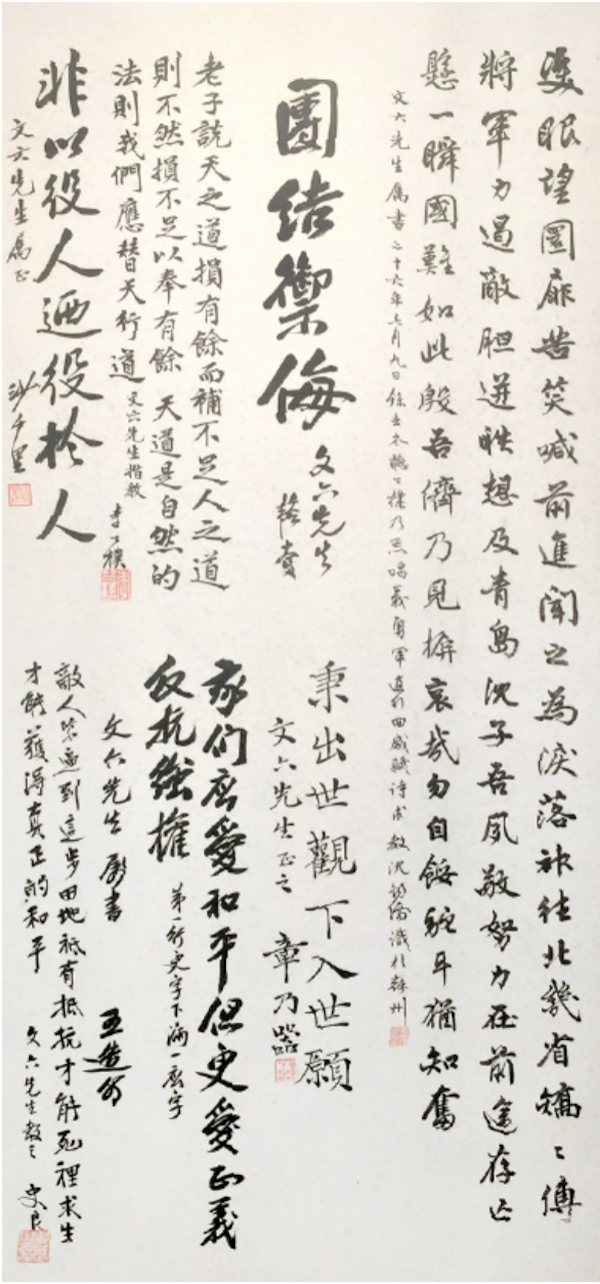
"Seven Gentlemen" and other related titles

The seven gentlemen took a group photo in front of Ma Xiangbo's apartment. Front row from left: Sha Qianli, Shi Liang, Ma Xiangbo, Wang Zaoshi, Li Gongpu; back row from left: Du Chongyuan, Zhang Naiqi, Zou Taofen, Shen Junru
In early spring, when I arrived at Crane City on the banks of the Oujiang River, the weather was unusually hot and sultry. I took off my cotton coat and walked into the government compound looking a little disheveled. Zhao Junhao, head of Qingtian Zhang Naiqi Research Association, thought we were here to promote some products, so he was a little hesitant. When we explained our purpose, he received us very warmly. Since then, several cooperations have begun: holding exhibitions, publishing pictures and catalogs, and holding seminars.
In the autumn and winter of 2019, I suggest holding a Zhang Naiqi seminar in Qingtian. Arrive at the meeting place one day in advance. It is naturally a pleasure to meet new and old friends, and the topic focuses on Zhang Naiqi research. I said that most researchers now suffer from the lack of new historical materials, and some basic research books are also lacking, such as chronicles. What can be seen now are only simplified notations and memorabilia, and some are full of mistakes. It would be appropriate to create a chronicle . Many friends on the side agreed, and some friends expressed that they did not have the energy to complete it. In this way, we will stop discussing and continue to hold seminars.
three
Not long after returning to Shanghai, the Gengzi novel coronavirus was raging. I took the usual practice of writers when avoiding the epidemic, writing and reading, and ran from home to the office almost every day at two o'clock and one hour to write "The Annihilated Imperial Capital: A Journey to the Huaihe River". One evening when the manuscript was coming to an end, I stood in front of the office window, overlooking the empty streetscape of the city, and suddenly thought of the conversations I had with my friends at the end of last year, so I contacted Zhao Junhao and decided to make a 100,000-word Chronicle of Zhang Naiqi ". At the turn of spring and summer, the project establishment of the chronology has been completed, and it has entered the implementation stage. I have formulated the plan and style of compilation, made a sample draft, and clearly divided the division of labor; I have sorted out and summarized the materials I have accumulated for a long time, and sent staff to Shanghai. Consult the library for relevant books and periodicals. Soon, the 100,000-character Chronicle of Zhang Naiqi took shape.
Things are always changing. When interviewing Wang Changfan, a research expert of the Democratic Construction Association and the Federation of Industry and Commerce, he said that the newly published "Shi Fuliang Chronicle" is about 300,000 characters long, and the 100,000-character Chronicle of Zhang Naiqi is obviously too small. My old friend Feng Qin is currently presiding over the work of the "Chronicles of Characters Since the Late Qing Dynasty" series at Shanghai Jiaotong University Press. He suggested expanding the volume and including "Chronicles of Zhang Naiqi" in the long series of publications.
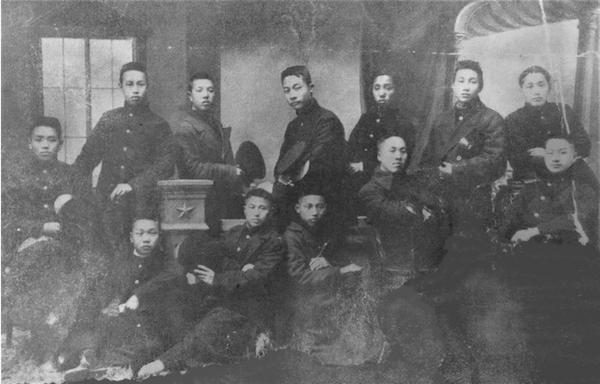
Zhang Naiqi (first from the right) took a group photo with his classmates
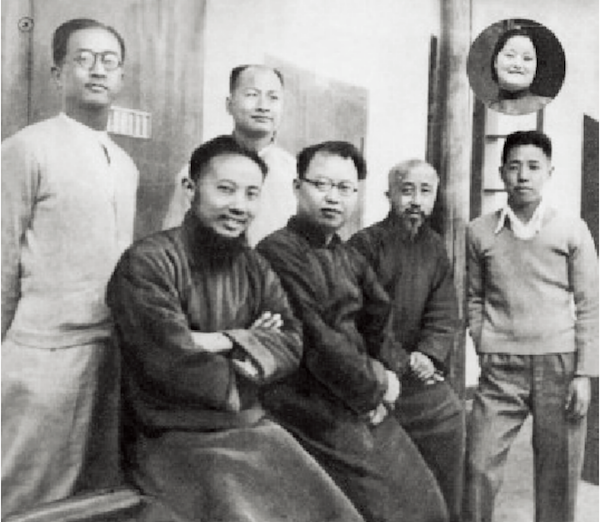
Since Shi Liang was imprisoned in a women's prison, he could not take a photo with the other six people. When publishing photos, newspapers and magazines at that time added Shi Liang's profile picture
Zhang Naiqi experienced the three historical periods of the late Qing Dynasty, the Republic of China, and the People's Republic of China. His life spanned 80 years, and his life was full of ups and downs. He was also an important party and participant in some influential historical events, and he left a lot of commemorative articles , Memoirs, and he is diligent in writing, has a lot of works, and is good at speeches, leaving some speeches. Commemorative and reminiscent articles can let people today understand his activities in different periods; his writings, articles and speeches clearly reflect his thought development and life pursuits, and there are certain objective conditions for making a long edition. At the same time, it is also the responsibility of our generation of scholars to make full use of this subject, without wasting a lot of precious historical materials, and to reflect the relatively complete and true appearance of this historical figure in the form of a chronicle.
In this way, I communicated my friends' suggestions and my own thoughts with Zhao Junhao, and after reaching a consensus, I followed the requirements of the chronicle editor.
Four
Making a chronicle is a labor-intensive task, and you can't squeeze out a lot of dry goods without consulting a lot of information. Moreover, there is no room for any imagination and assumptions, and we can only use scientific methods to arrange, compare, analyze, and judge, to remove the false and keep the truth, and to search for the history closest to the truth.
This job is quite boring, and in order to verify Zhang Naiqi's activities on a certain day, he needs to consult different materials. If there is no preference for this historical figure at the beginning, it is impossible to continue. For example, the writing and publication date of his articles need to be verified. In addition to the collections that have marked the date of publication or writing, some of them only indicate the number of series published in a certain weekly or monthly magazine. It is necessary to verify the publication date of the current issue, or consult the original published magazines, or for weekly, monthly The publication date of the monthly magazine is inferred. Of course, after each boring textual research, it is enough to be able to verify and discover new historical materials, which is also enough to make people happy. After the victory of the Anti-Japanese War, Zhang Naiqi returned to Shanghai from Chongqing. Many memoirs in the past believed that it was in May and June of 1946. According to the analysis of historical materials I have, it should be in mid-April. On April 12, the Central Committee of the Democratic National Construction Association moved to Shanghai, and held the first joint meeting of executive directors and supervisors in Shanghai; on April 18, "South China News" reported that Zhang Naiqi participated in "Shanghai Cultural Circle Supports the Nantong Massacre" and protested to the authorities "Five Requirements" campaign. Confirmation as mid-April seems justifiable. But could it be more accurate? I called Wang Changfan, did Zhang Naiqi attend the April 12 meeting held by the Democratic National Construction Association in Shanghai? He consulted "Huang Yanpei's Diary" and related historical materials, but there was no list of attendees. Instead, he found in the records of "Huang Yanpei's Diary" on April 12 that on the morning of April 10, Huang Yanpei and Zhang Naiqi, together with Zhou Xiaohuai and others Records of long conversations. In this way, the relatively accurate time of Zhang's return to Shanghai was determined, and the previous statement was revised.
The Chronicle also discovered some new activities of Zhang Naiqi. In early 1938, he went to Anhui from Hong Kong to take up his post, and stayed in Wuhan. Promoted to director. This has not been written in previous biographical and memoir articles.
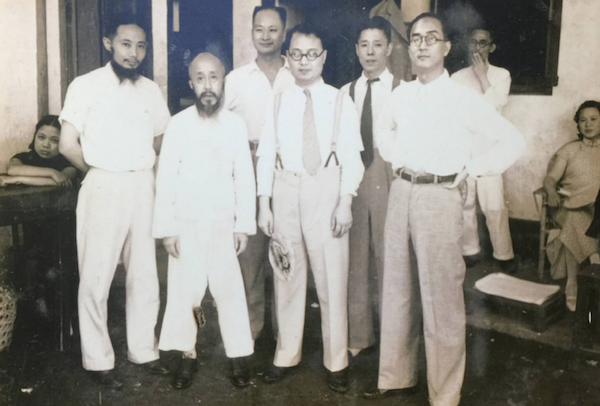
Li Gongpu, Shen Junru, Zhang Naiqi, Wang Zaoshi, Sha Qianli and Zou Taofen (from left) take a group photo in prison

Zhang Naiqi speaks at the National Committee of the Chinese People's Political Consultative Conference
The chronology records events by year, month, and day, which can naturally shield some rumors and restore the historical truth; it can also restore the facts that the researcher and the recaller intentionally or unintentionally avoided in a specific social environment; Error raised. Because the order of time does not tolerate conflicts of facts. For example, in the past, there were often memoir articles saying that Zhang Naiqi visited the Soviet Union with Mao Zedong and Zhou Enlai in the early days of the founding of the People’s Republic of China, but I found that Zhang Naiqi was still active in Beijing when Mao Zedong and others were in the Soviet Union. When exactly did he go to the Soviet Union? Much of the source is not precise, nor is his memoir. When I checked the materials of the delegation that visited the Soviet Union in the early 1950s, I finally figured out the time, reason, and identity of his visit to the Soviet Union...
five
The long compilation of this chronology tries to collect Zhang Naiqi's published articles and works in various historical periods as the main basis for summarizing or summarizing. Strive to objectively, accurately and completely reflect the development and changes of his thoughts and views in different historical periods, so that readers can have a full understanding of this process; take his social activities as the main clue, supplemented by the expression of living conditions, and use a certain It reflects the specific events that happened on a certain day of a certain month in a certain year. When I consulted a large amount of relevant historical materials, I found that recallers and writers in different periods either praised or derogated.
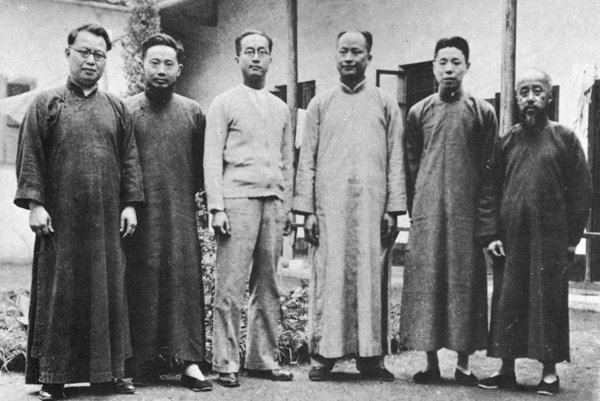
In 1936, from left, Wang Zaoshi, Li Gongpu, Zou Taofen, Zhang Naiqi, Sha Qianli, Shen Junru
After the manuscript was sent to the publishing house, they believed that it reflected the characteristics of the unity of information, academics and biography, and it was the first long compilation of chronicles reflecting Zhang Naiqi's life experience, and they applied for the 2021 Shanghai Book Publishing Special Fund to win the Success, which inspires our enthusiasm to work hard to do a good job in editing. Why do we say "we"? Most of the content of this yearbook was written by me, and some friends took time out of their busy schedules to participate. What is even more gratifying is that some young students joined the writing team under the recommendation of their supervisors, including graduate students from the School of Mathematics of Fudan University and the School of Journalism of Lanzhou University. They sorted out and summarized Zhang Naiqi's articles and related reports published in "New Review", Chongqing "Ta Kung Pao", "Hua Shang Bao" and "People's Daily". I see this research being followed up. For various reasons, some of them have not been published until some of them have graduated. Now the "Zhang Naiqi Chronicle Long Edition" with more than 600,000 words has finally come out, and the regrets of the past are in the past.
Attachment: Selection of selected cultural relics donated by Zhang Naiqi

Bronze Minister Chen Fu Yi You
Bronze Minister Chen Fu Yi You. business. The overall height is 42.8 cm, and the largest diameter is 19.8 cm. Straight mouth, long neck, drooping belly, ring feet. Animal head rope handles. The cover edge, neck and feet are each decorated with two sets of animal face patterns. This pot is exquisite in shape, simple in decoration and beautiful in workmanship. Unearthed in Luoyang, Henan.
Bronze Yakou Fugui Ding. business. It measures 24.8cm high and 20.8cm wide. The body is round, with a deep abdomen, three-column feet, double erect ears, and a square mouth. The neck is decorated with scroll patterns and Kui patterns, and the belly is decorated with banana leaf patterns. The inscription "Ya□Fugui" is on the inner wall of the vessel.

Ding Ding
Bronze Asian father Ding Ding. business. Overall height 22.7cm, width 18.3cm. Cuboid, with a flat mouth and folded edges, two ears standing on top, a deep abdomen, a flat bottom, and four-column feet. The heels of the feet are decorated with taotie patterns.
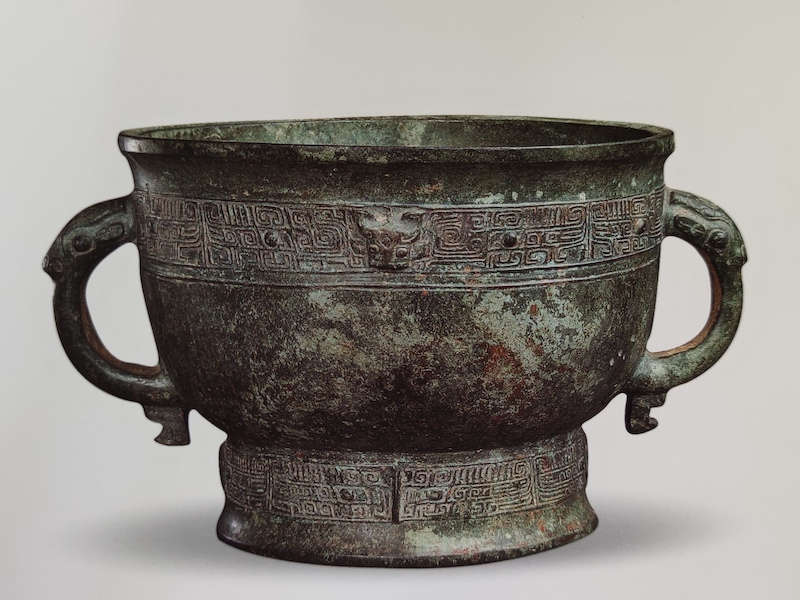
Bronze Gui
Bronze gui. business. Overall height 14.2 cm, diameter 19.7 cm. Folded mouth, straight wall and deep abdomen, double ears, circle feet. The neck decoration has a circle of animal face patterns, and there are two raised sacrificial heads in between. The circle feet are decorated with animal face patterns. The upper part of the ear is decorated with animal heads, and the lower part is a drop ear. There are inscriptions inside.
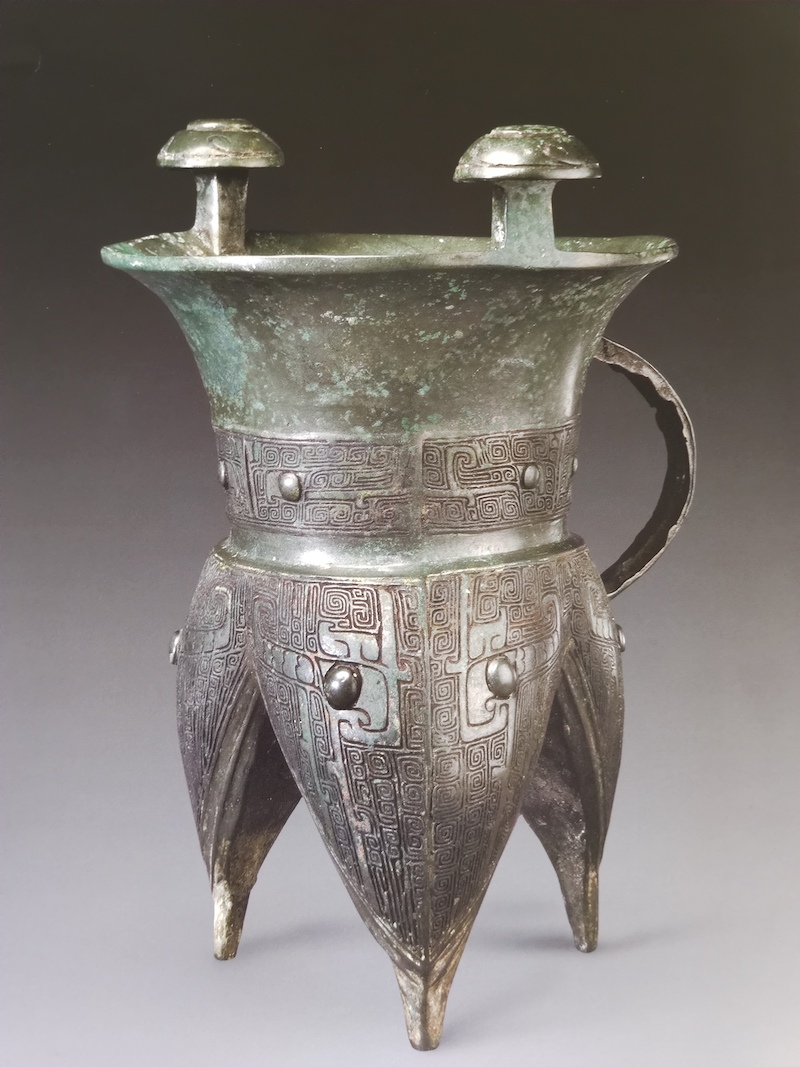
Bronze animal mask
Bronze animal-mask pattern. business. Overall height 34cm, width 27.5cm. Larger body shape. The whole body is finely decorated.

Bronze Pannaea Ge
Bronze Pannaea pattern Ge. Late Shang Dynasty. Overall length 26.6cm x width 8.7cm. There is an inner curved appendix, which is in the shape of a long ox tongue, with upper and lower appendages, and the inner curvature is relatively large. The casting is excellent, and the silkworm pattern on the inside is vivid and realistic.
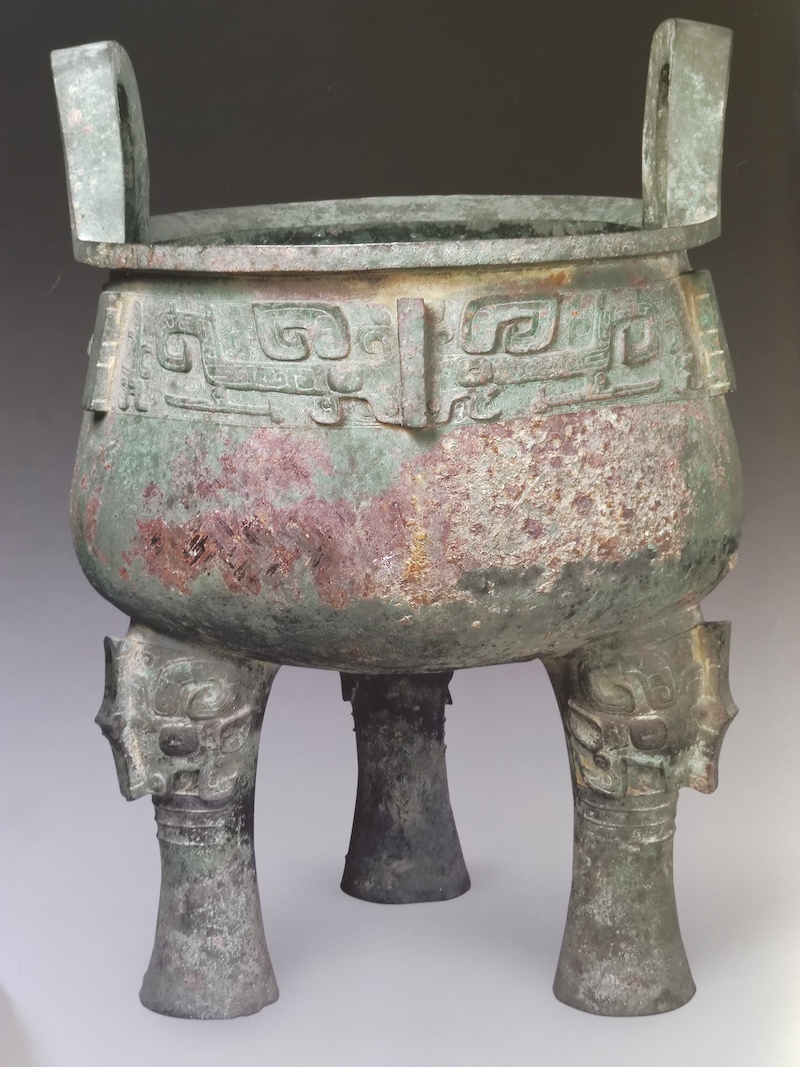
Bronze tripod with animal face pattern
Bronze tripod with animal face pattern. Western Zhou Dynasty. Overall height is 62.9cm and width is 49cm. Caliber 45 cm. Round style, erect ears, flat edge folded outward, column foot. The lower mouth and the heel of the feet are decorated with animal-mask patterns, and the edge of the door is also decorated.
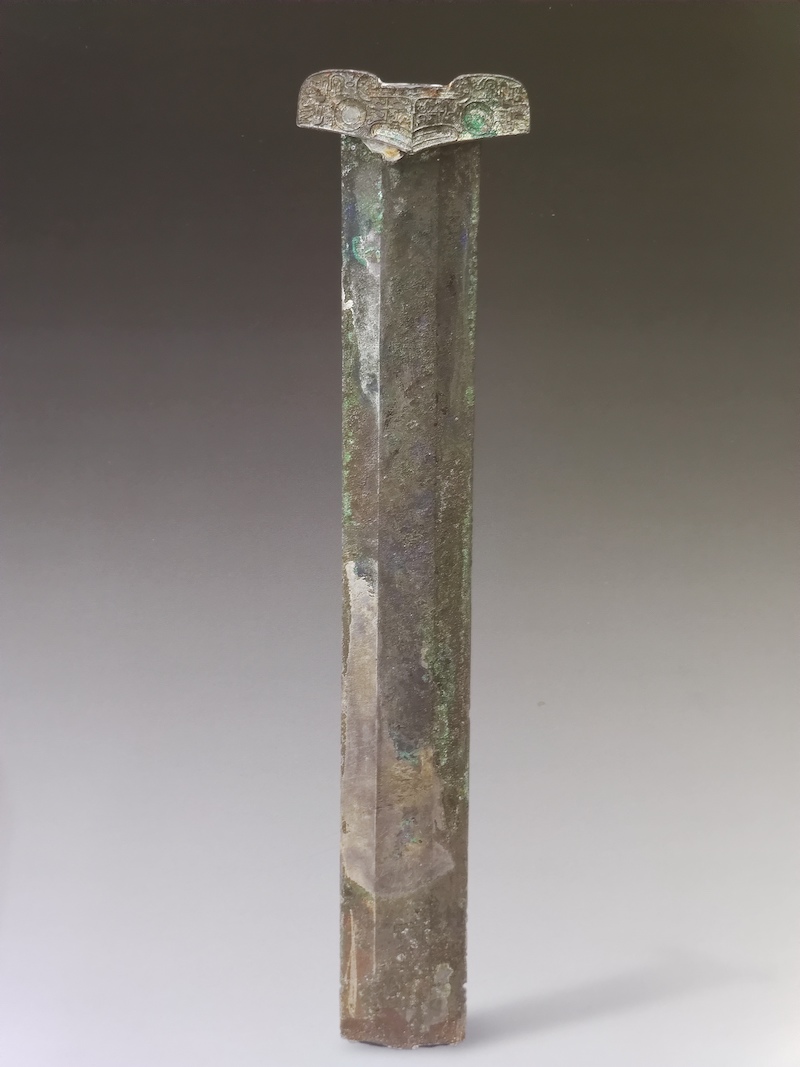
Bronze Yuewang Sword
Bronze Yuewang Sword. spring and autumn. The overall height is 25.8 cm and the width is 6.4 cm. The sword is broken. The two sides are parallel, and the thick grid is concave. Bird seal script inscription: "Xu Wangzhou sentence, self-use sword." This sword is very exquisite.
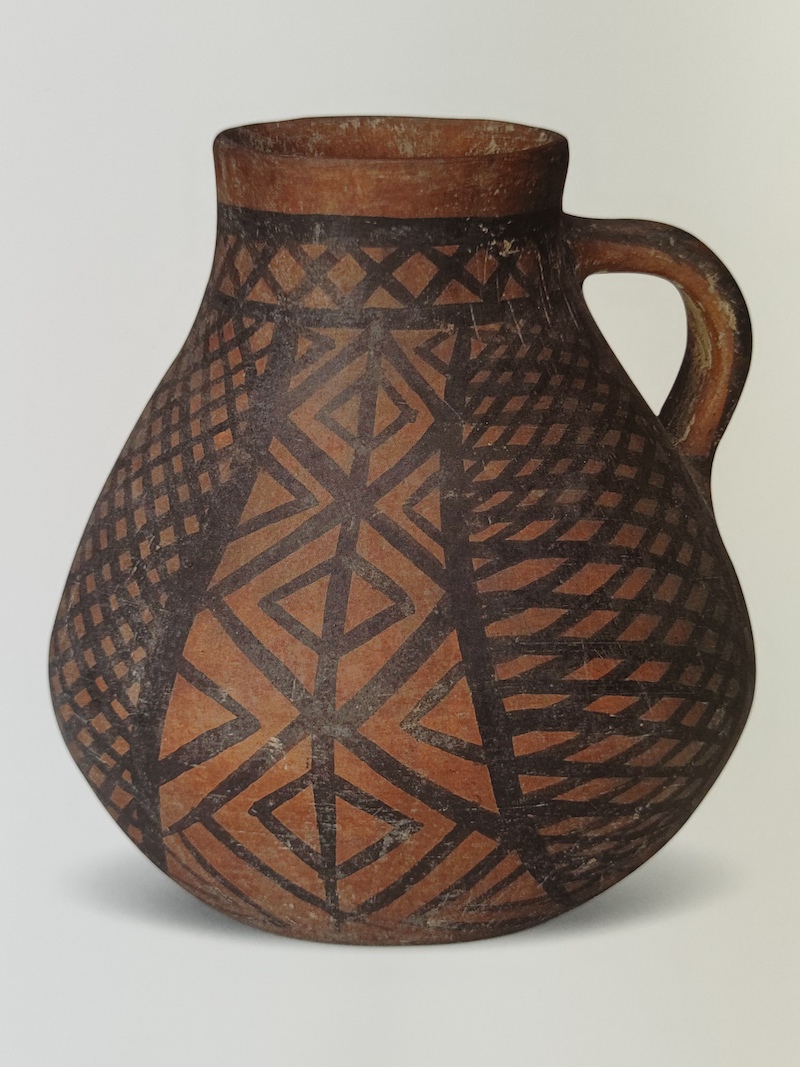
Mid-mountain type painted pottery
Mid-mountain-shaped faience. Neolithic. 14 cm high, 6 cm in diameter, 5.4 cm in base diameter. Red soil, black painted grid pattern and rhombus pattern on the body.

Celadon three series jar
Celadon three series jar. Sui. Height 17.6 cm, mouth diameter 4.5 cm, foot diameter 6.5 cm. The celadon glaze is applied on the body of the vessel, the glaze color is blue and yellowish, the exterior glaze is not applied to the bottom, there is a phenomenon of drooping glaze, and the glaze surface is finely broken. The bottom is unglazed.
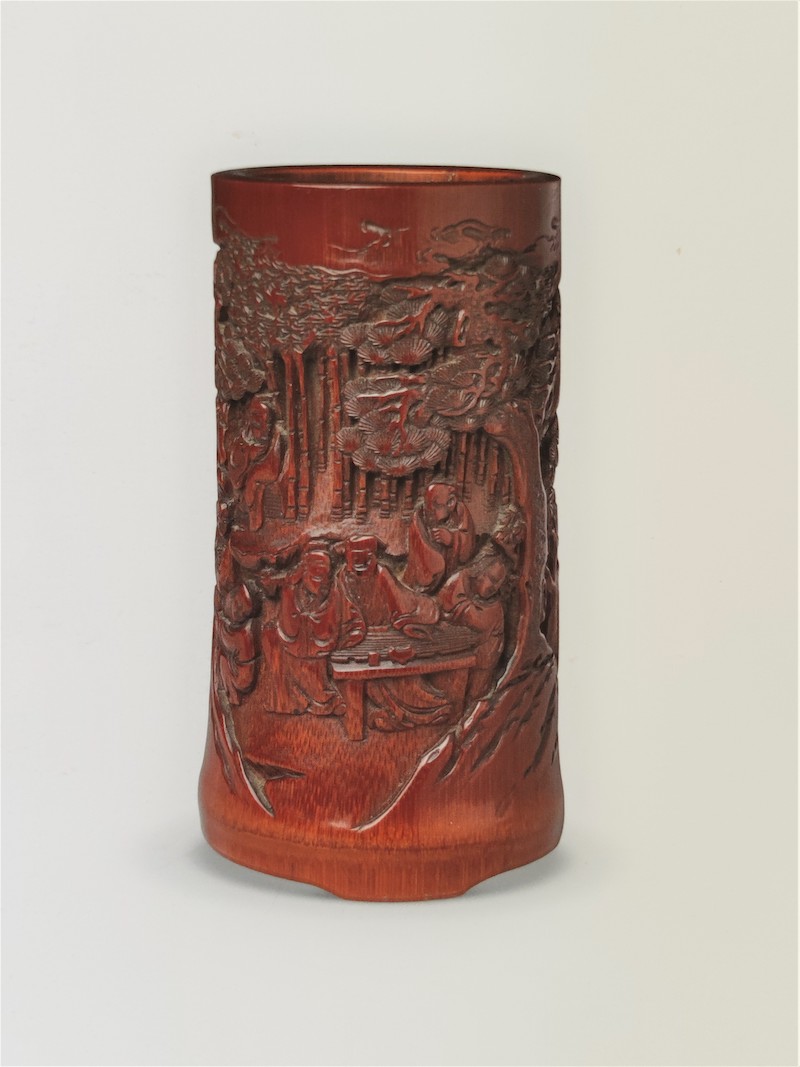
Bamboo Carved Seven Sages of the Bamboo Grove Pen Holder
A pen holder with a bamboo carving of the Seven Sages of the Bamboo Grove. clear. Height 11.9 cm, diameter 5.9 cm. The barrel is thinner, with a round mouth and three short legs. The outer wall is smooth and ruddy, and the color is like steamed chestnut. The theme of the decoration is the seven sages of the bamboo forest and the boy, a total of 10 people, divided into two parts and four groups.

Agarwood Wood Carved Landscape Figure Silver Cup
Agarwood carved silver cup with landscape and figure patterns. clear. Height 6.1 cm, maximum diameter 5 cm. This cup comes in a set of 10. The cup is inlaid with a layer of silver lining. The roughness and simplicity of the ornamentation has a unique charm, and it is an excellent work among the agarwood woodcarvings.
Collection and donation entries in "Chronology of Zhang Naiqi"
1948 (the thirty-seventh year of the Republic of China) 52 years old
On August 16, the historian Jian Bozan was sponsored to host archaeological activities on Boliao Island. The activity was hosted by the Hong Kong Southern College founded by Zhang Naiqi. Professors Ma Jian and Hou Baozhang of the University of Hong Kong, Ye Lingfeng, a Hong Kong historian and geographer, Deng Chumin, a professor of Dade College in Hong Kong, Lin Huanping, the dean of the Southern College, and more than 60 students participated in the excavation. Reporters from South China Daily and Overseas Chinese News also attended the interview. Archeology has obtained stone axes, pottery fragments and other Neolithic relics.
53 years old in 1949
On April 9, Zhang Naiqi and other 329 people from the cultural circles in Peking issued a joint statement condemning the crime of stealing cultural relics by the reactionary traitorous government of the Kuomintang in Nanjing.
In my spare time, I visit the cultural relics market, mainly shops in Longfu Temple and Liulichang, as well as street stalls in Dongdadi (near Hongqiao today).
54 years old in 1950
On the evening of February 11th, Zheng Zhenduo, Song Yunbin, Zhao Wanli and others were invited to dinner. During the banquet, he displayed his collection of "Li Longmian's A Fang Gong Tu" and said: "This is not a fake copy, and it can be viewed."
57 years old in 1953
On December 9th, a letter was sent to Zheng Zhenduo.
Summary I will be moving in forty days. In order to save trouble, I hope that your bureau can receive a batch of my cultural relics before or shortly after the move. Otherwise, it will be very laborious to move there together, and move to your place in the future, and it will be worrying to leave it in the same place for a long time, and there will be many problems in occupying other people's houses. Please consider how to do it first, and a decision will be made in person soon.
On December 17, I sent a letter to Li Tongcun, chairman of Shangchuan Enterprise Company, saying: "All the money I spent was used to buy antiquities; the salary income from the past years, if I used it, I also invested in antiquities. It is now planned to donate all the money to the Central Ministry of Culture. "
58 years old in 1954
In January, Zheng Zhenduo sent six experts from the Forbidden City to receive cultural relics. "Father opened up all the cabinets for him to choose. After screening for about a month, more than 1,100 collections were selected. For example, Yuzu Ding You in the Shang Dynasty, Yafu Sigui, and Western Zhou Dynasty Duo You, Spring and Autumn Yuewang Sword, Tang Xing Kiln White Glaze Vase, Song Longquan Kiln Celadon Five-Tube Cap Vase, Qing Dynasty Bamboo Carving, Taotie Tripod Tripod with Two Ears and other fine works have all entered the collection of the Forbidden City this time.”
59 years old in 1955
This year, a batch of cultural relics were donated to the Chinese People's Committee for the Defense of World Peace.
61 years old in 1957
On November 5, the Beijing Higher People's Court filed a lawsuit against Zhang Naiqi, the original shareholder of Shangchuan Enterprise Co., Ltd., requesting that the defendant be ordered to "liquidate the accounts of Shangchuan Enterprise" for the first time.
The plaintiff sued for "resisting the socialist transformation of the enterprise", "evading business administration", "tax evasion", "private usury", "undermining foreign exchange management", "concealing adverse property", "hoarding and speculating", "invading 561 company funds", etc. , and asked the court to freeze Zhang Naiqi's deposits and seize the collected cultural relics. "The father argued in court, but the other party was at a loss for words. At that time, the court tried to mediate, but the plaintiff objected."
67 years old in 1963
On May 29, "a few people based on some one-sided statements" filed a petition to the court of the original instance, "falsely claiming that the father had taken out and replaced the cultural relics in the family."
On November 11, the court of first instance again made a ruling, counting all cultural relics in Zhang Naiqi's family, sealing them up on the spot, and temporarily executing them. Zhang Yijun wrote: “On the same day, about 20 people, including judges, clerks, bailiffs, civilian police, and street cadres, led by the vice president of the judge, broke into my father’s house in an attack, and threatened my father to agree to the immediate seizure, but was rejected. My father tactfully stated that They gave the reason and asked not to execute it temporarily. They turned a deaf ear and started to collect cultural relics and seized them on the spot."
1964 aged 68
On June 16, the petition was submitted to the Supreme People's Court, and the reasons were stated again, and their own opinions were presented:
8. Whether the donation of cultural relics has been negotiated. Many of the plaintiffs are very clear. At that time, Li Tongcun, the chairman of Shangchuan Company, was fully aware of it; Zi Yaohua, the head of the public-private joint venture bank, also agreed.
1986
On May 15, the "Exhibition of Collecting Cultural Relics" opened at the China History Museum in Beijing. The more than 300 pieces of cultural relics on display were selected by the Chinese History Museum from more than 5,000 pieces of cultural relics acquired and received from private donations over the years. donate. For example, Ni Zan's "Shuizhuju Picture Scroll", Xu Youzhen's "Peach Blossom Book House Picture Scroll", Zhou Chen's "Canglang Pavilion Picture Scroll", Wen Zhengming's "Zhenshangzhai Picture Scroll" were donated by Mr. Sun Zhao's family; The sapphire fretwork ring and the bronze bow-shaped vessel with the human face and dragon pattern of the Shang Dynasty were donated by the family of Mr. Zhang Naiqi.
2007
On the afternoon of September 29, the exhibition of cultural relics donated by Mr. Zhang Naiqi was held in Jingren Palace of the Palace Museum in Beijing. Among the cultural relics collected by the Palace Museum, there are 1,192 donated by Zhang Naiqi. These donated cultural relics are divided into several categories such as bronzes, ceramics, stones, sculptures, jades, currency, bamboo and wood tooth horns, and lacquerware. Attending the opening ceremony were Geng Baochang, Hu Deping, and descendants of Li Jishen, Huang Yanpei, Zhang Bojun, Cheng Qian, Ma Xulun, Hu Ziang, Lu Zuofu, Sha Qianli and others. The exhibition will end on April 26 of the following year.
year 2010
In July, "Donate Zhang Naiqi", edited by the Palace Museum and edited by Li Mijia, was published by the Forbidden City Publishing House.
2017
On December 28, "Patriotic Feelings - Exhibition of Cultural Relics Donated by Zhang Naiqi" opened at the National Museum of China. The more than 110 pieces of cultural relics displayed this time are selected from the cultural relics donated to the National Museum of China by Zhang Naiqi and his family members. Parts, including bronzes, bronze mirrors, jade, ceramics, etc., from the Neolithic Age to the Qing Dynasty.
Lu Zhangshen, curator of the National Museum of China, said that the National Museum specially planned this exhibition to commemorate Zhang Naiqi's patriotic feelings of "changing a family treasure into a national treasure" and express his gratitude to the cultural relics donors who have been selflessly dedicating to the cause of the museum. tribute. The exhibition will last until January 31, 2018.
